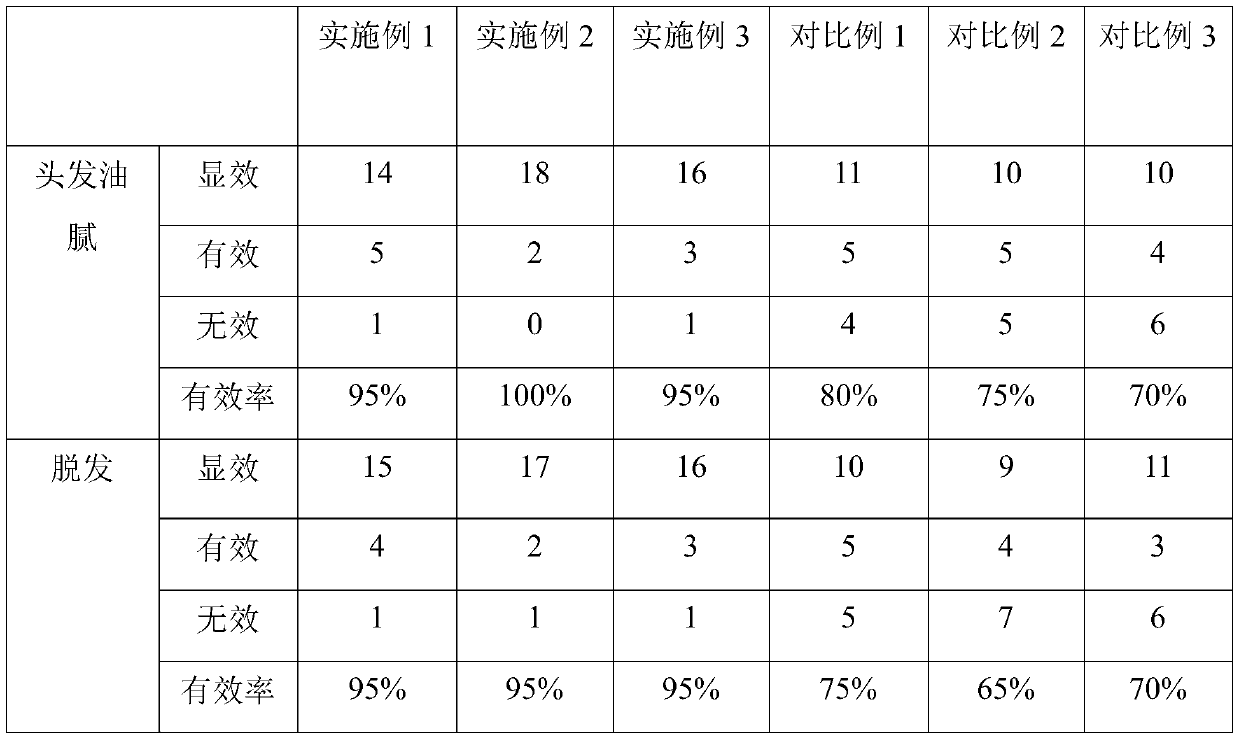Traditional Chinese medicine shampoo and preparation method thereof
A technology of shampoo and traditional Chinese medicine, which is applied in the directions of medical formula, hair care, drug combination, etc., can solve the problems of environmental pollution, scalp irritation, poor use effect, etc., and achieve the goal of solving greasy hair, reducing irritation, and enhancing effect Effect
- Summary
- Abstract
- Description
- Claims
- Application Information
AI Technical Summary
Problems solved by technology
Method used
Image
Examples
Embodiment 1
[0025] A traditional Chinese medicine shampoo, comprising the following raw materials in parts by weight: 1 part of saponins, 1 part of sapindus, 1 part of moutan cortex, 1 part of arborvitae leaves, 1 part of ligusticum and 1 part of angelica dahurica; the traditional Chinese medicine shampoo also includes methyl Glucoside polyoxyethylene (120) ether dioleate, sodium N-lauroyl sarcosinate and ethylhexylglycerin, methyl glucoside polyoxyethylene (120) ether dioleate, N-lauroyl sarcosine Sodium nitrate and ethylhexylglycerin account for 4%, 10% and 0.1% of the total weight of the shampoo, respectively.
[0026] The preparation method of above-mentioned Chinese medicine shampoo, comprises the following steps:
[0027] (1) Weigh saponins, sapindus, Moutan cortex, arborvitae leaves, ligusticum and Angelica dahurica respectively, then soak sapindosa and sapindus in clear water for 20 hours, and then put sapindosa and sapindus in 8 times water Heat to 100°C, keep warm for 120min, f...
Embodiment 2
[0030]A traditional Chinese medicine shampoo, comprising the following raw materials in parts by weight: 2 parts of saponins, 2 parts of sapindus, 1 part of moutan cortex, 1 part of arborvitae leaves, 1 part of ligusticum and 1 part of angelica dahurica; the traditional Chinese medicine shampoo also includes methyl Glucoside polyoxyethylene (120) ether dioleate, sodium N-lauroyl sarcosinate and ethylhexylglycerin, methyl glucoside polyoxyethylene (120) ether dioleate, N-lauroyl sarcosine Sodium nitrate and ethylhexylglycerin account for 5%, 15% and 0.3% of the total weight of the shampoo, respectively.
[0031] The preparation method of above-mentioned Chinese medicine shampoo, comprises the following steps:
[0032] (1) Weigh saponins, sapindus, Moutan cortex, arborvitae leaves, ligusticum and Angelica dahurica respectively, then soak sapindosa and sapindus in clear water for 24 hours, then add sapindosa and sapindus to 9 times of water Heat at 100°C, keep warm for 140min, a...
Embodiment 3
[0035] A traditional Chinese medicine shampoo, comprising the following raw materials in parts by weight: 4 parts of saponins, 4 parts of sapindus, 2 parts of Moutan cortex, 2 parts of orientalis leaves, 2 parts of Ligusticum edulis and 2 parts of Angelica dahurica; the traditional Chinese medicine shampoo also includes methyl Glucoside polyoxyethylene (120) ether dioleate, sodium N-lauroyl sarcosinate and ethylhexylglycerin, methyl glucoside polyoxyethylene (120) ether dioleate, N-lauroyl sarcosine Sodium nitrate and ethylhexylglycerin account for 6%, 20% and 0.5% of the total weight of the shampoo, respectively.
[0036] The preparation method of above-mentioned Chinese medicine shampoo, comprises the following steps:
[0037] (1) Weigh saponins, sapindus, Moutan cortex, arborvitae leaves, ligusticum edulis and Angelica dahurica respectively, then soak sapindosa and sapindus in clear water for 30 hours, then put sapindosa and sapindus in 10 times of water Heat to 100°C, kee...
PUM
 Login to View More
Login to View More Abstract
Description
Claims
Application Information
 Login to View More
Login to View More - R&D
- Intellectual Property
- Life Sciences
- Materials
- Tech Scout
- Unparalleled Data Quality
- Higher Quality Content
- 60% Fewer Hallucinations
Browse by: Latest US Patents, China's latest patents, Technical Efficacy Thesaurus, Application Domain, Technology Topic, Popular Technical Reports.
© 2025 PatSnap. All rights reserved.Legal|Privacy policy|Modern Slavery Act Transparency Statement|Sitemap|About US| Contact US: help@patsnap.com


